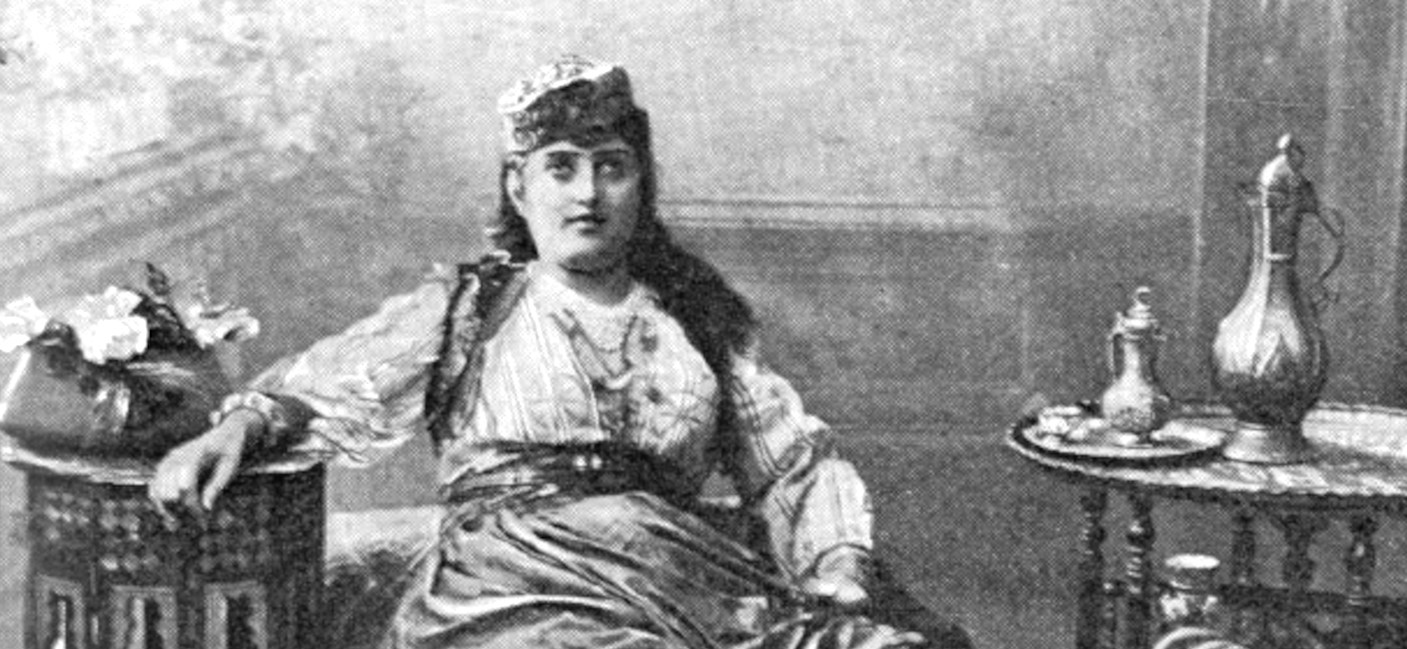From the early sixteenth century to the Industrial Revolution, coffee houses spread from the Middle East throughout Europe and grew into important political, economic, and social institutions.
Coffee had conquered everyone’s hearts and palates, continuing to be drunk privately and publicly. The history of coffee therefore continued in the salons and shops of France in 1644, in England in 1652, in the United States around 1670, and in Germany in 1679.
In this Article
[Why do our men] trifle away their time, scald their Chops, and spend their Money, all for a little base, black, thick, nasty bitter stinking, nauseous Puddle water?
Women’s Petition Against Coffee (1674)
With the Arab coffee trade from the port of Mocha, coffee spread to the Adriatic Coast and to Italy. A Turkish ambassador introduced the French to coffee. Retreating Ottoman soldiers abandoned bags of coffee seeds at the gates of Vienna, and Turkish merchants sold coffee in Venice.
[Coffee causes] an excessive state of brain-excitation which becomes manifest by a remarkable loquaciousness sometimes accompanied by accelerated association of ideas.
It may also be observed in coffee house politicians who drink cup after cup . . . and by this abuse are inspired to profound wisdom on all earthly events.
Lewis Lewin
As for European coffeehouses, there are several stories – with Vienna, Paris, London, Germany, and Venice catching coffee fever by the early 1700s. The history of the “first” coffeehouse in Europe is highly disputed and interesting, Austrians, French, British, and Italians claim the primacy, of the earliest European coffee cultures, making the conditional obligatory:
In the beginning there was the Italian Coffeehouses
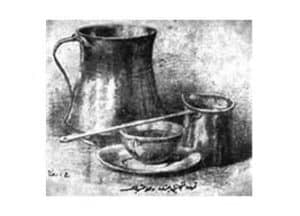
In Venice, there had long been some knowledge of coffee, because of its economic relationship with the spice trade and its proximity to the Ottoman world. From around 1570, a sizable community of Turkish merchants had lived in a house in the Rialto assigned to them by the Signoria (government).
These men certainly drank coffee in the city, as is attested by an inventory of the goods of a textile merchant, Huseyin Çelebi, who was murdered in Venice on 20 March 1575. Among the list of his personal belongings and goods was his tableware, which included his finian (fincan in Turkish) cup used for drinking coffee.
Although there are several slightly different hypotheses, the most widely accepted is that, in 1580, Venetian botanist and physician Prospero Alpini imported coffee (named Bun at the time) into the Republic of Venice from Egypt. In the 1630s, coffee beans were reportedly sold by apothecaries in the city, suggesting that the drink was consumed, at least by some, as a medicine.
Italian historians believe that the first coffee shop arose in Venice soon after however, some place it in 1647, others in 1676. Historian Lemaire says that Venice’s first registered coffee shop was built in Piazza San Marco, under the porticoes of the Procuratie Nuove, in 1681, while historian Daniele Rava claims that it dates back to 1683. It seems that a shop had already been opened in Livorno in 1632 by a Jewish merchant.
Established towards the end of the 18th century, grand coffee houses, acquired cultural importance in Italy (or the lands that were to become Italy).
The “first caffè” in Italy rose in the eighteenth century in Venice, where in 1720 Caffè Florian opened at the commercial port frequented by Turkish merchants. This is followed by the Pedrocchi of Padua (1722), the Gilli in Florence (1733), the Greco in Rome (1760), and the Gambrinus of Neaples (1890).
The caffès became meeting places for artists, intellectuals, and politicians. Caffè culture was mainly enjoyed by men, but soon women organized their coffee, tea, or hot chocolate times first at home and later in coffeehouses.
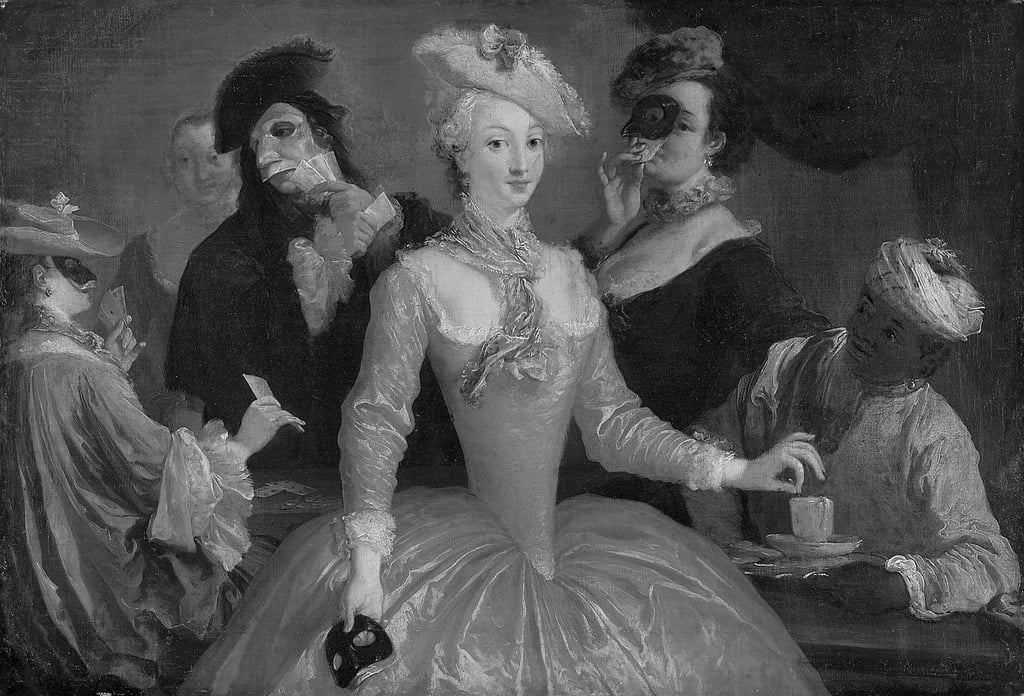
Coffeehouses proliferated to the point of becoming the defining feature of a newly emerging public sphere; they became a place increasingly associated with novelty and news.
VIENNA – In the beginning there was the Wiener Kaffeehaus – coffeehouse
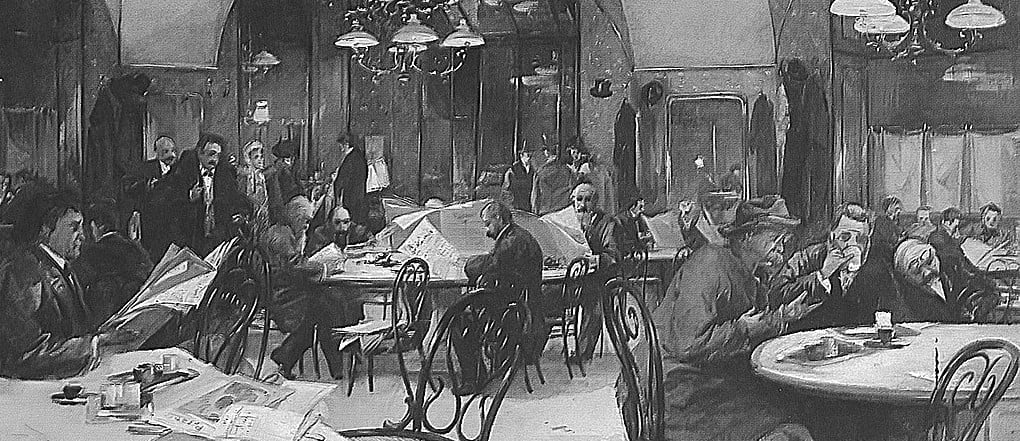
Franz Georg Kolschitzky
During the Turkish-Prussian war,Vienna was invaded by the Turkish army. Legend has it that the Turks left bags of coffee behind when they left the city. Franz Georg Kolschitzky was a Polish nobleman, diplomat, and spy during the Great Turkish War. He recognized the value of the coffee beans and opened a coffee house in 1683 – some say 1684. Apparently, he had lived in Turkey and introduced the idea of filtering coffee in Vienna.
The shop with the sign “Zur blauen Flasche” (“To the blue bottle”), was equipped with rough tables and long benches and was visited by Count Starhemberg and Prince Eugene of Savoy. In 1697, coffee was served in large cups, accompanied by large wooden spoons.
“Since the color of the drink was as repugnant to the sight of his fellow citizens as its acrid taste was repugnant to their palates.”
Historian, Gérard-Georges Lemaire I Caffè letterari, 1988.
Kolschitzky had the idea of adding milk and honey to sweeten it, as well as to filter it. This is how Viennese coffee was born.
Pfizer, – Kipferl, – Croissant
Lee Stewart Allen refers to this legend in his book, Devil’s Cup. A History of the World According to Coffee:
Back in 1683, during the Turkish siege of Vienna, a baker named Peter Wender heard a curious tick! tick! while working late at night in his basement bakery. It was the Turks digging their secret tunnels. He warned the city officials and later created a sweet bread roll shaped like the Turks’ crescent moon to advertise his contribution to the war effort.
A similar story is also told in Hungary, but with Budapest as the setting, not Vienna.
Using bread as political propaganda was quite common back then; when King Gustav Adolf II of Sweden ravaged Germany only fifty years earlier, every gingerbread in the area was soon decorated with Adolf’s face transformed into a child-eating monster.
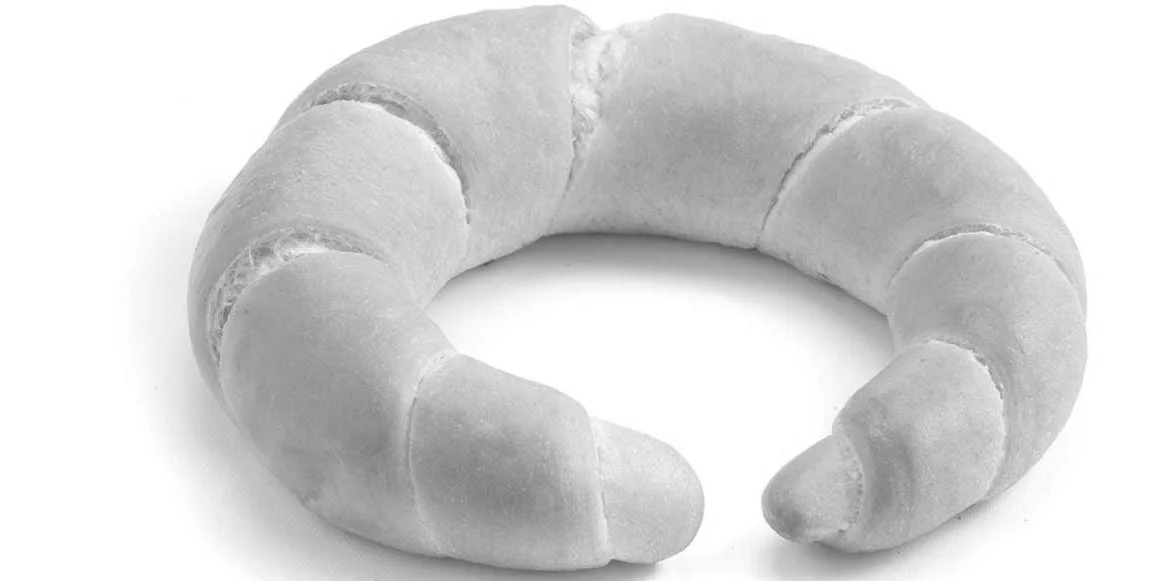
After the Turks were defeated, it became the Viennese custom to serve Wender’s little crescent roll, called the Pfizer, with morning coffee. And there it would have ended except that a century later, a seventeen-year-old Viennese princess named Marie Antoinette moved to Paris to marry Louis XVI, king of France. Homesick, she insisted that the French bakers learn to make pfizer for her breakfast using yeast dough (brioche). The bakers added butter and yeast, and since it would have been unthinkable for a queen of France to eat anything but “French” pastry, they renamed it le croissant de lune, which means crescent moon in French.
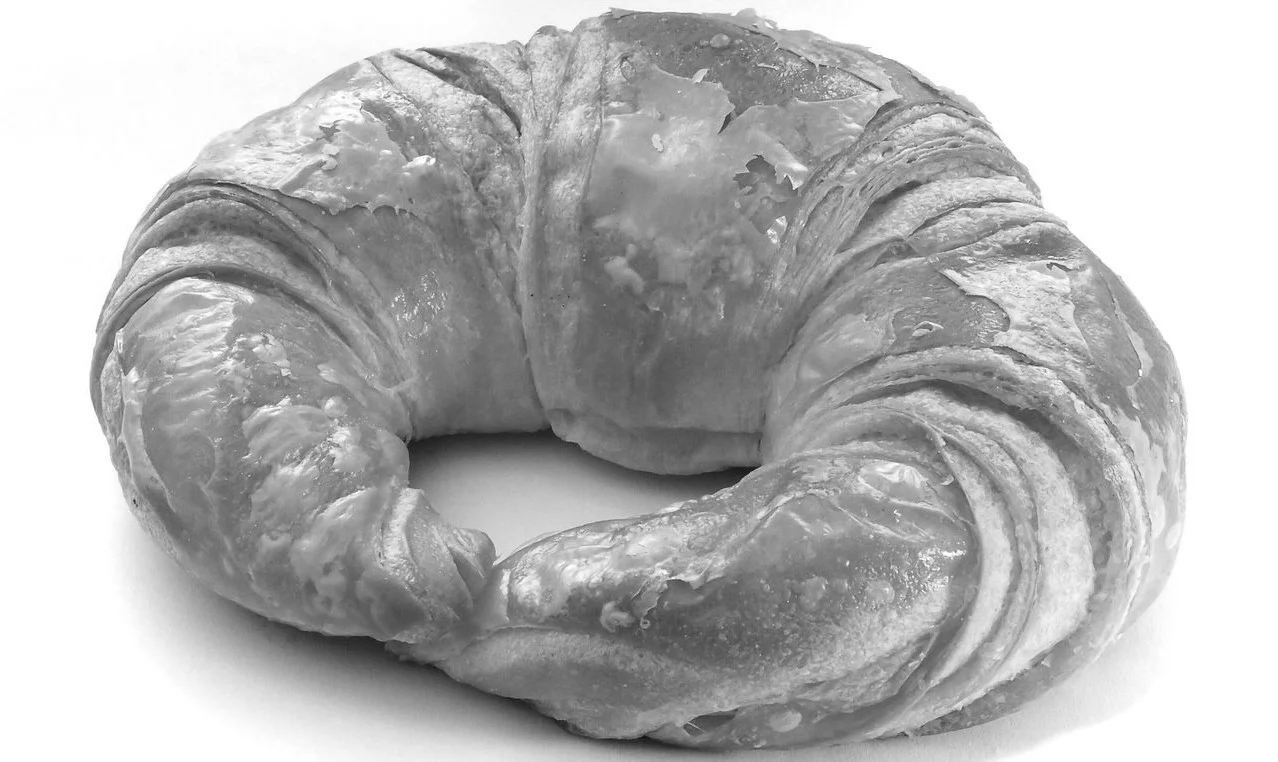
Another story attributes the Kipferl to Austrian official August Zang, founder of the Boulangerie Viennoise (Viennese Pastry Shop) in Paris around 1839, whose specialty was Kipferl along with other Austrian pastries. Its typical crescent shape soon changed the name into what we still know today as a croissant.
The relations between Austria and Italy in 1683 were so intense that, in a few years, the crescent bun crossed over into North Italy. The Italian croissant recipe today differs from the croissant due to the presence of eggs in the dough and a greater quantity of both butter and sugar.
Another account tells how the cornetto came to South Italy. In 1768, Maria Carolina of Habsurg married Ferdinand IV of Bourbon and was crowned Maria Carolina, Regina (queen) di Napoli e Sicilia. Along with coffee, Maria Carolina brought the Kipferl (the cornetto) to Neaples; the successful coffee-cornetto pairing was recommended to her by her sister Maria Antonietta of France.
Since then Kaffee has been accompanied by Kipferl, croisants, and other sweet delights.
Some historians date the first Viennese coffee house to 1685, opened by Johannes Theodat. Early coffee houses offered their customers a color chart depicting various shades of brown, lighter or darker, from which they choose their particular hue preference.
It was not until much later the Viennese coffee menu sutured the classic Melange, Kapuziner, Franziskaner, Grosser/Kleiner Brauner, Grosser/Kleiner Schwarzer, Einspänner, Verlängerter, the rum-laced Fiaker, and the complex Kaisermelange.

Lee Stewart Allen in his The Devil’s Cup: A History of the World According to Coffee, explains how to drink a Kaisermelange. [Cappuccino, as it is called in the original text, has no whipped cream!]
I met the Countess, my nickname for her, in Café Demel, a place that prides itself on serving Kaisermelange exactly as at the turn of the century: strong brewed coffee, not espresso, a howl of chocolate shavings, and a dome of Schlagober (whipped cream) on a silver platter.
The Countess had been so horrified by my attempt to consume this concoction that she volunteered to give me a lesson.“You Americans have been spoiled by zee straw,” she said. The Countess looked a bit like Vienna herself, old but beautiful, or at least well maintained. Certainly rich. But cruel, especially about the mouth, the lips of which were lacquered to a Porsche-like gloss. Pearls gleamed milky white among the family of small animals draped about her neck.
One of Café Demel’s black-clad waitresses placed a fresh cappuccino on our table, and the Countess proceeded with my lesson. First, she piled her Schlagober on the coffee, sprinkling it lightly with the chocolate shavings. “You eat zo.” She made a delicate gesture with her spoon, then a vicious stabbing motion. “Not like zat. You are not killing somezing, ya?” I’d stabbed down through the whipped cream in an attempt to blend the coffee with the cream.
The proper way, according to the Countess, was to let the whipped cream melt into the coffee while you nibbled it and the chocolate shavings. When the whipped cream receded to within a half inch of the coffee, it was permissible to break the crust. You could raise the cup to your lip at this juncture.
Under no circumstances, however, would you drink or allow your lips to touch the whipped cream. Instead, you inhale the elixir, sucking the coffee toward you through the Schlagober and spraying a java-flavored patina upon your palate. A slight slurping sound is permissible.
“Zen, ven all is safe and zee Schlagober is gone, you may drink. Zee coffee in zee cup should be like zis shade of brown, you see? “Zee first part, ven you eat zee Schlagober of the cappuccino, is like childhood, Steuart—all sweet, light, and frivolous. Zee second part is like middle age.” The Countess paused. “But I have nozing poetic to say about zat.”She went on, “And za last is old age, black and bitter, perhaps, but maybe zee best part for zose who have developed a taste.”
The largely male waiting staff, presided over by a major domo known as Herr Ober, meant there was little likelihood of coffee houses being mistaken for houses of ill repute.
Female guests were welcome, but dark interiors and the masculine atmosphere meant many women preferred to meet each other for coffee at the cake shop or Café-Konditorei. Women met for their Kaffeeklatsch, a gathering over coffee to chat or gossip, also at home.
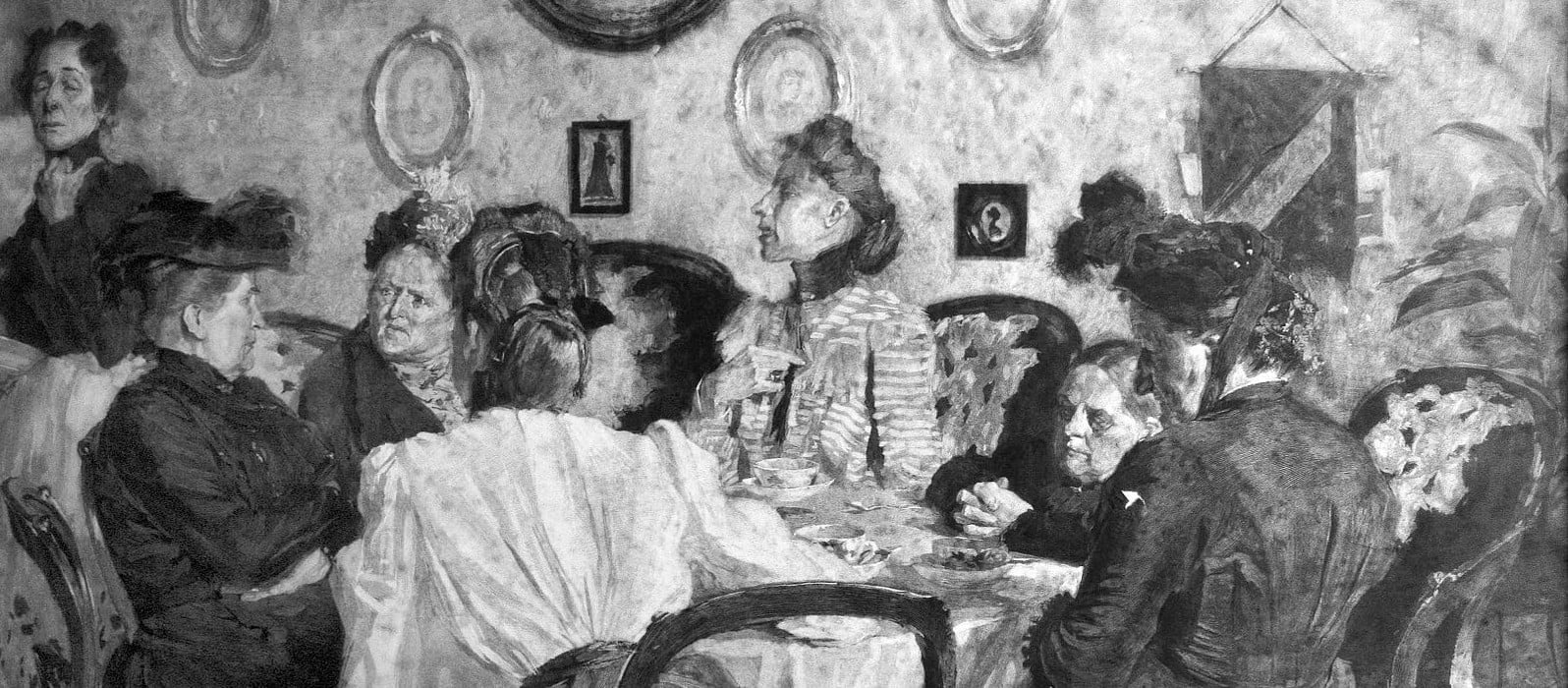
As the centuries progressed, the Viennese coffee house evolved into something more than just a place to get a cup of coffee. Although coffee houses were ubiquitous throughout the city, each had its own atmosphere and attracted a distinct clientele based largely on academic, political, or cultural interests, as well as social class.
Viennese coffee houses were the favorite haunts of such notables as Alfred Adler, Sigmund Freud, Theodor Herzl, Gustav Klimt, Egon Schiele, Arthur Schnitzler, Stefan Zweig, as well as countless others whose names and lives have since vanished from history. Leon Trotsky was reported to be particularly fond of the Café Central. The popularity of the coffee houses can be attributed to the unique social function they served.

In addition to excellent coffee and small meals, traditional Viennese coffee houses offer their guests the opportunity to sit in a comfortable surrounding and read the news of the world by drawing local and, frequently, foreign newspapers from racks. This was an important service at a time before radio, television, and the interne. It still persists today.
However, not all coffeehouses hosted such highbrow clientele: some were haunts for criminals, scoundrels and pimps.
PARIS – In the beginning there was the Parisian café

Although coffee arrived in the port of Marseille as early as 1644, it remained largely unknown to the people and was used mostly for medicinal purposes by the French elite. This changed following the visit of a delegation from Ottoman Sultan Mehmed IV to the court of King Louis XIV in 1670.
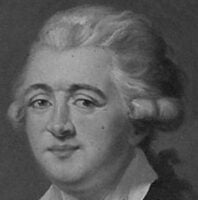
During their stay of almost one year, the delegation pampered the court with Turkish delicacies, including coffee. This sparked a wave of ‘Turkomania’ among courtiers, and the new fashion soon trickled down from Versailles to the streets of Paris, where coffee street sellers and coffee houses sprang up.
It was a young Sicilian from Palermo, Francesco Procopio dei Coltelli, who became Frenchized into Procope de Cousteau, who in 1686 made use of the monopoly granted to the guild of distillers (known as limonadiers) to sell both alcohol and coffee to seated customers by opening the Café Procope.
A venue where guests could sip their drinks from porcelain cups, seated at marble tables, and surrounded by gilded mirrors, painted ceilings, and chandeliers.
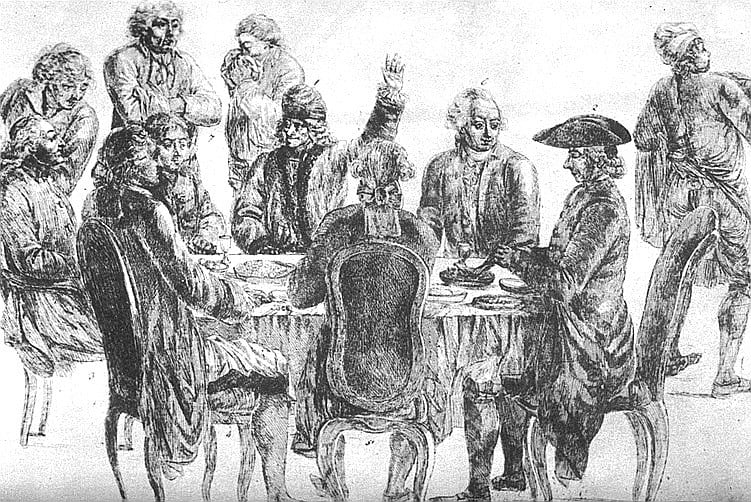
The Procope set the tone for what would become the Parisian café: a space for exchange and inspiration, where revolutions were conceived and debates stirred.
Historian Jules Michelet went so far as to describe the advent of the café as an ‘auspicious revolution’ that modified human temperament,’ and from its outset, the café was indeed frequented by artists and intellectuals. Honoré de Balzac drank his coffee black and on an empty stomach to cover paper with ink; Rousseau and Diderot were known regulars; and Voltaire even wrote a play called The Coffee House. The café was also, as a senior diplomat wrote in 1685, a place where
All sorts of people assemble, especially foreigners
– making it a cause for some concern for the French establishment.
Café Procope, in rue des Fossés-Saint-Germain, opposite the Comédie Francaise also was called The Cave, due to its poor lighting, became the cradle of the Enlightenment and the headquarters of the Revolution. Among the many, D’Alembert, Marmontel, Robespierre, Danton, Marat, Mirabeau, and Hèrbert frequented it.
In Paris, a café was much more expensive and far more luxuriously decorated than its British counterpart. An English traveler to Paris in 1701 could hardly contain his awe, writing:
‘There’s one coffeehouse near the Pont-Neuf, where there are no less than 34 marble tables! I have seen another with Looking-Glass all about it.’
Following the revolution of 1789, cafés increasingly opened in more modest areas of the city, where working-class patrons socialized through coffee, tobacco, and gambling, perched at the bar or seated at one of the tables spread across the sidewalk.
It was in the Procope, (possibly – as for the revolutions, they were actually conceived in salons, which were held not in coffee shops but at private homes) that during Napoleon’s time General Malet prepared his revolt (October 22–23, 1812).
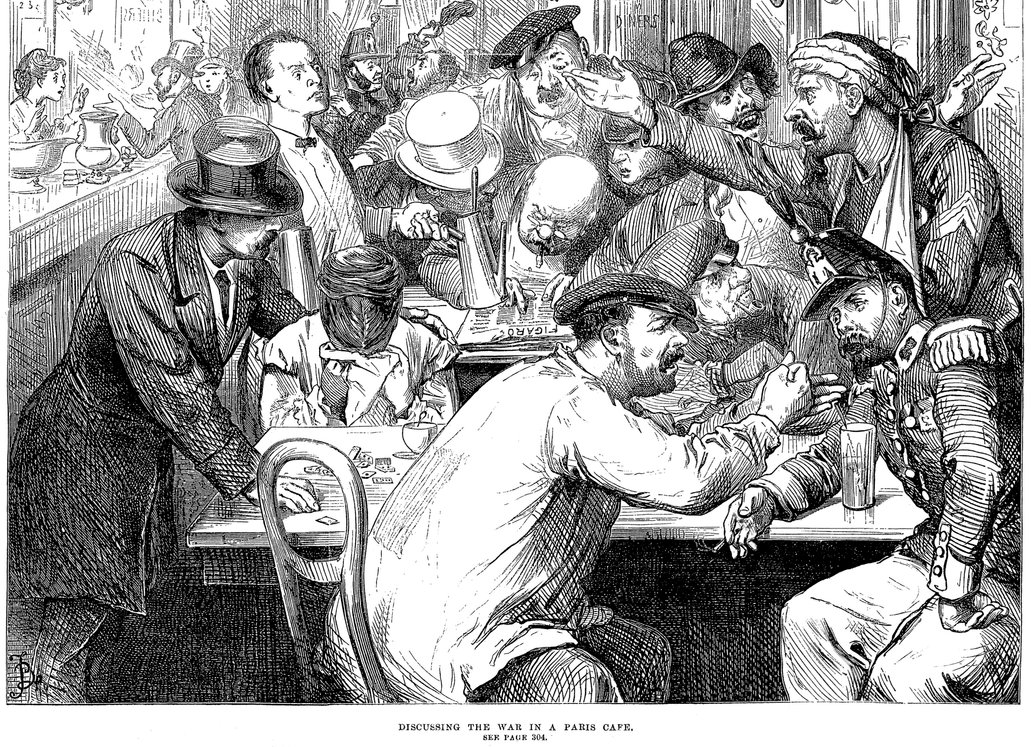
The Procope was later frequented by Balzac, Gautier and De Musset. Closed in 1872, it was reopened in 1893 and Huysmans, Anatole France, Wilde and Verlaine sat there. In addition to the Procope other cafés were centers of the political and literary life of Paris, so much so that Jules Michelet said:
“All of Paris is one great café”.
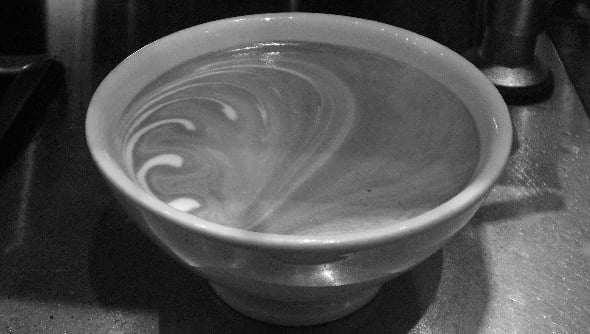
According to coffee historian Jonathan Morris, very few women set foot in cafés for fear of being mistaken for prostitutes. Bourgeois women preferred to imbibe chocolate-flavored drinks, which were considered more feminine and to have medicinal qualities.
This changed somewhat with the introduction of the Café au lait, which became a symbol of the Parisian café. The association of coffee and milk achieved a threefold goal: firstly, it legitimized coffee as a drink for women because a milk-based beverage seemed closer to hot chocolate and therefore more ‘appropriate’ for women to consume. Café au lait’s sweetness and calorific value made it a breakfast staple and a regular item in cookbooks.
Today, Café au lait and Caffè latte are used as contrasting terms, to indicate whether the beverage is served in the “French” or the “Italian” way, the former being in a white porcelain cup or bowl, the latter in a high glass and always made with an espresso, whereas café au lait might be espresso – or filter coffee-based.
At this point, coffee seemed to have won the hearts of France, with affection encompassing men and women, as well as the poor and rich.
London – In the beginning there were Oxford coffee houses

The first legendary coffee house in England was established by a Turkish Jew named Jacob at the Angel in Oxford in 1652, in the building now known as the Grand Café. Two years later, another opened in London at St. Michael’s Alley off Cornhill, with the coffee probably imported by Daniel Edwards, who traded in Turkish goods.
It was managed by his Greek servant, Pasqua Rosée and known as Pasqua Rosée’s Head. He printed the first coffee advertisement, a broadside touting “The Vertue of the Coffee Drink,” described as:
A simple innocent thing, composed into a Drink, by being dryed in an Oven, and ground to Powder, and boiled up with Spring water, and about half a pint of it to be drunk, lasting an hour before, and not Eating an hour after, and to be taken as hot as possibly can be endured.
Pasqua Rosée made extravagant medicinal claims; his 1652 ad asserted that coffee would aid digestion, cure headaches, coughs, consumption, dropsy, gout, and scurvy, and prevent miscarriages. More practically, he wrote,
“It will prevent Drowsiness, and make one fit for business, if one have occasion to Watch; and therefore you are not to Drink of it after Supper, unless you intend to be watchful, for it will hinder sleep for 3 or 4 hours.”
Coffee houses must still have been relatively unknown by 1657 and not universally appreciated because James Farr, proprietor of the Rainbow coffee-house at Inner Temple Gate, was prosecuted for having “evil smells” caused by “a sort of liquor called coffee”. However, they soon caught on as an alternative to inns, or public houses. No alcohol was sold in coffee-houses and women were often not permitted to enter.
In December 1660 Samuel Pepys wrote in his diary:
“[Coll. Slingsby] and I in the evening to the Coffee-house in Cornhill, the first time that ever I was there. And I find much pleasure in it through the diversity of company – and discourse.”
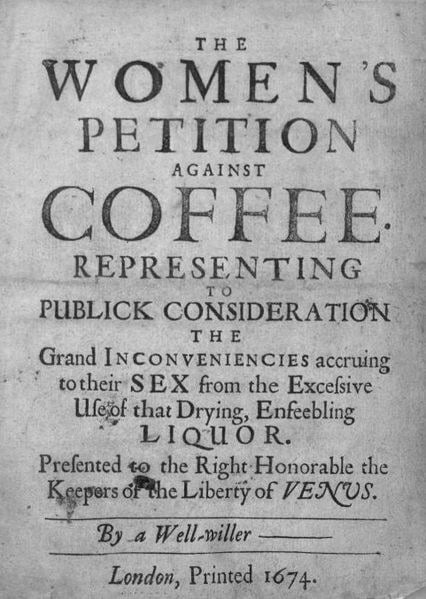

Houghton Library Harvard University
By 1700 there were 2000 such establishments in London and such was their liveliness, that women stood up against them. Because, unlike their Continental counterparts they were excluded from this all-male society (unless they were the proprietors). In 1674, The Women’s Petition Against Coffee was published, claiming that coffee made men impotent – as
‘unfruitful as the deserts where that unhappy berry is said to be bought’.
A response and defense to it appeared in the same year, in the form of The Mens’ Answer to the Womens’ Petition Against Coffee. Far from rendering them impotent,
“[coffee] makes the erection more Vigorous, the Ejaculation more full, adds a spiritual escency to the Sperme.”
Of course, there is absolutely no evidence that coffee plays a part in indulgences and conditions and, in fact, more recent research has postulated that coffee may increase sperm mobility, thereby increasing male fertility.
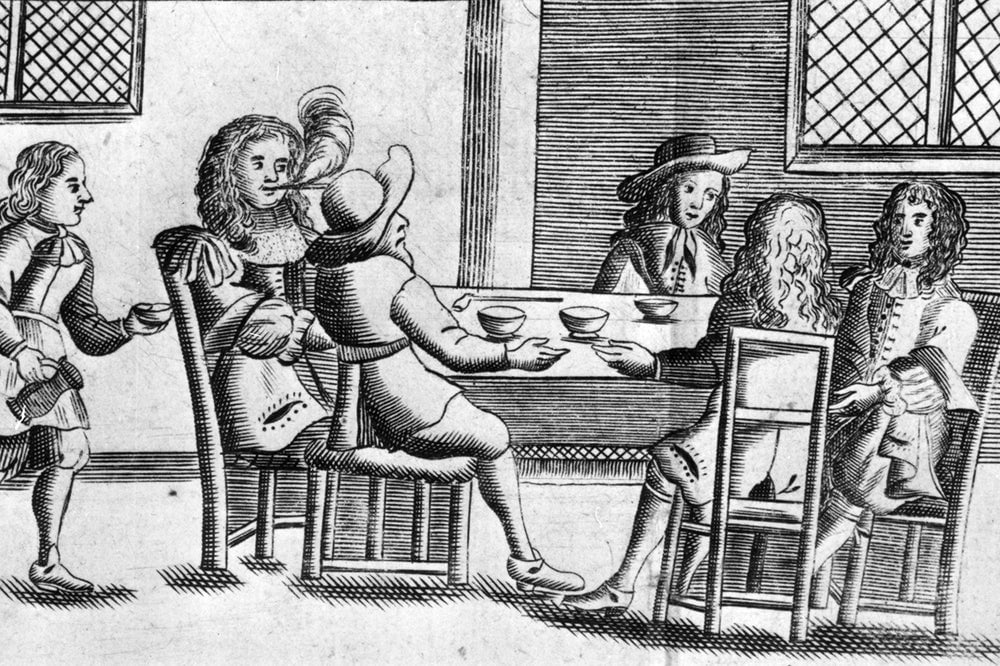
On December 29, 1675, King Charles II issued A Proclamation for the Suppression of Coffee Houses. In it he banned coffeehouses as of January 10, 1676, since they had become
“the great resort of Idle and disaffected persons”
where tradesmen neglected their affairs. The worst offense, however, was that in such houses “divers false, malicious and scandalous reports are devised and spread abroad to the Defamation of his Majestie’s Government, and to the Disturbance of the Peace and Quiet of the Realm.”
Charles II banned them momentarily, fearing that they were hotbeds of freethinking and revolutionary fervor. On January 8, two days before the proclamation was due to take effect, the king backed down.
Ironically, however, over the course of the 18th century, the British began to drink tea instead of coffee. Most of the coffeehouses turned into private men’s clubs or shop houses by 1730, while the huge new public tea gardens of the era appealed to men, women, and children alike. Unlike coffee, tea was simple to brew and did not require roasting, grinding, and freshness. (It was also easier to adulterate for a tidy additional profit.) (Pendergrast Mark)
The British colonization of India had begun, and there they concentrated more on tea than growing coffee. The British East India Company pushed tea through its monopoly in China, and smugglers made tea cheaper. While the black brew never disappeared entirely, its use in England diminished steadily until recent years. Later coffee was grown in Chickmangalore area and other parts of South India.
German Kaffeehaus
Coffee and coffeehouses reached Germany in the 1670s. By 1721 there were coffeehouses in most major German cities. For quite a while, the coffee habit remained the province of the upper classes. Many physicians warned that it caused sterility or stillbirths.
Later in the century, coffee-obsessed Ludwig van Beethoven ground precisely sixty beans to brew a cup.
As Pendergrast Mark writes: By 1777 the hot beverage had become entirely too popular for Frederick the Great, who issued a manifesto in favor of Germany’s more traditional drink:
“It is disgusting to notice the increase in the quantity of coffee used by my subjects, and the like amount of money that goes out of the country in consequence. My people must drink beer. His Majesty was brought up on beer, and so were his ancestors.”
Zichorienkaffee
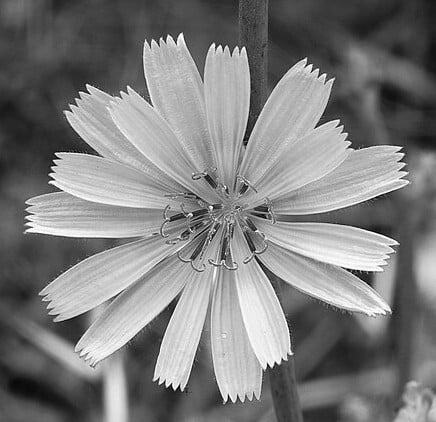
Four years later, the king forbade coffee’s roasting except in official government establishments, forcing the poor to resort to coffee substitutes, such as roast chicory root, dried fig, barley, wheat, or corn.
During the 1770s chicory, a plant indigenous to Germany and coffee taste-alike made with roasted chicory root, created a whole new industry. In Brunswick and Magdeburg Ersatz coffee, known as Prussian coffee, experienced a real boom when Napoleon blockaded the seaports, with one factory alone employing 350 workers.
Various other kinds of roasted cereals were also used to eke out the supply of expensive beans, producing a concoction known as Bauernkaffee, peasants’ coffee, and along the Rhine as Muckefuck (a term often presented as a spoonerism of the French mocca faux, although this is questionable).”
In Europe, chicory was widely used as a coffee extender during economic crises such as the Great Depression in the 1930s and WWII. As chicory is less expensive than coffee, mixing it makes the blend more economical. Chicory is traditionally added to coffee in Indian, Spanish, Greek, Turkish, Syrian, Lebanese, Palestinian and North-American cuisines.
Kaffeeriecher – coffee smellers and Kaffeeklatsch – coffee chats
Some also managed to get hold of real coffee beans and roast them clandestinely, but government spies, pejoratively named “coffee smellers” by the populace, put them out of business.

Eventually, coffee outlived all the efforts to stifle it in Germany. While men could socialize in public, Frauen, woman, particularly loved their Kaffeeklatsch, private coffee visits, which usually took place at home in the morning or afternoon. This gossipy social interludes gave the brew a more feminine image.
In “Beyond Bratwurst: A History of Food in Germany, we read:
“This ritual became so influential across all cultural sectors that the Jewish population developed a kosher adaptation for occasions where coffee was to be served after a meal which had included meat, replacing milk or cream with beaten egg white.
The coffee habit quickly spread to poorer households, popularized as a break from the monotony of the day’s labour among those who worked at home. By 1780 coffee had replaced the morning bowl of soup or gruel.
References to coffee appeared in popular publications and were included in songs. In 1732 the drink had become controversial (and popular) enough to inspire Johann Sebastian Bach to write his humorous Schweigt stille, plaudert nicht, BWV 211 (aka the Coffee Cantata) in 1735, in which a daughter begs her father to allow her this favorite vice:
Dear father, do not be so strict! If I can’t have my little demi-tasse of coffee three times a day, I’m just like a dried up piece of roast goat! Ah! How sweet coffee tastes! Lovelier than a thousand kisses, sweeter far than muscatel wine! I must have my coffee, and if anyone wishes to please me, let him present me with—coffee!
It is said, this Kaffee Kantate was performed the first time at Zimmermanns Kaffeehaus in Leipzig.
A cartoon from around 1790 shows a distinctly well-nourished pair of townsfolk labeled Frau Kaffeeschwester, Madam Coffee-sister, and Herrn Bierwanst, Mr Beer-belly:
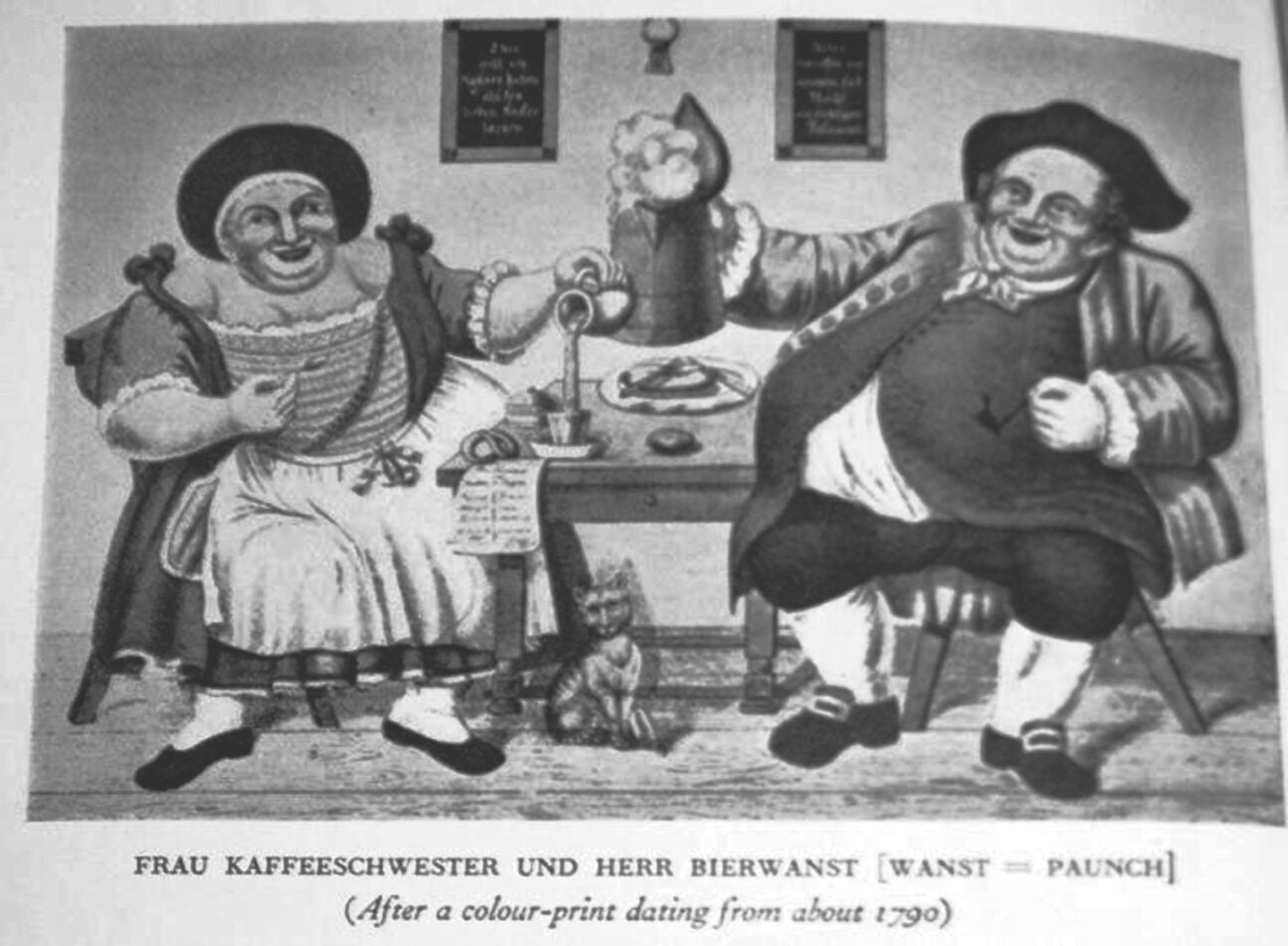
Coffee trade and Coffeehouses
Coffee reached the United States around 1670, and every other European country also discovered coffee during the same period. The beans reached Holland by way of Dutch traders. The Scandinavian countries were slower to adopt it—though today they boast the highest per capita consumption on earth.
In the United States, accompanied by the functional link between public coffee consumption and trade, contemporary culture and politics arose.
It is estimated that altogether at the turn of the 18th century to the 19th, there were several thousand cafés open in Europe. The art of cocktails comes to life, tea and infusions are served, and more and more cafés take on the role of cultural centers, especially for intellectuals and aristocrats. They are living rooms in all respects, places where you can talk about politics, literature or organize a revolution.
Coffee aided considerably in the sobering of an alcohol-soaked Europe and provided a social and intellectual catalyst as well. As William Ukers wrote in the classic All About Coffee,
“Wherever it has been introduced it has spelled revolution. It has been the world’s most radical drink in that its function has always been to make people think. And when the people began to think, they became dangerous to tyrants.”
Maybe.
Yet increasingly, as the European powers brought coffee cultivation to their colonies, the intensive labor required to grow, harvest, and process coffee came from imported slaves.
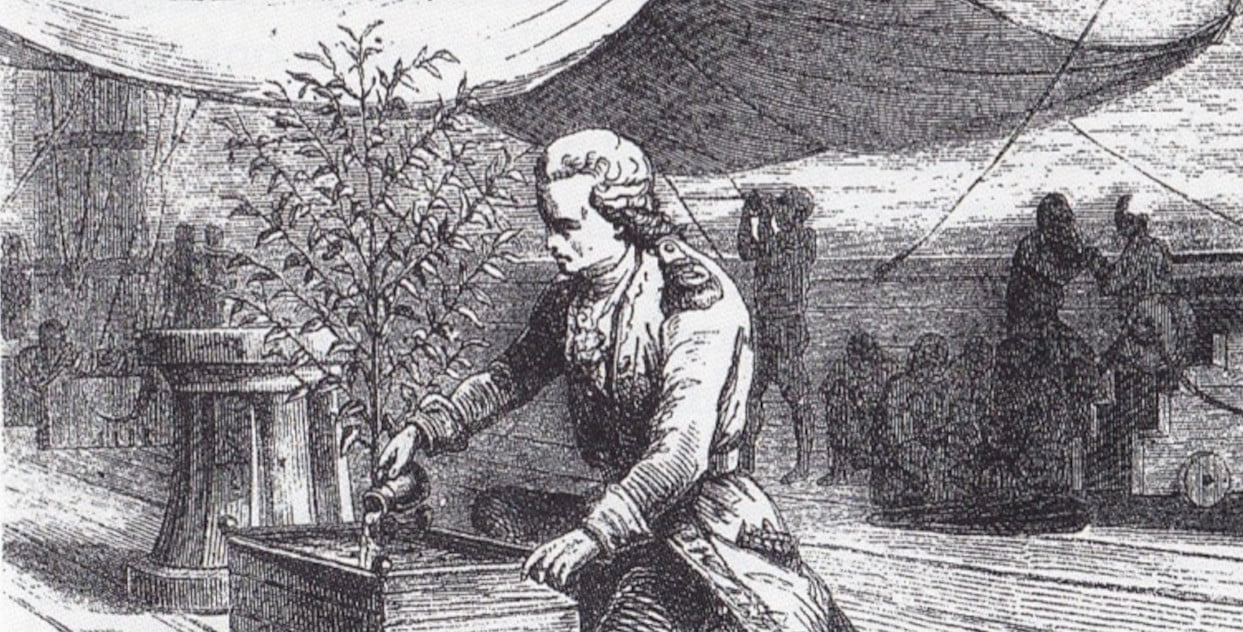
Captain de Clieu may have loved his coffee tree, but he did not personally harvest the millions of its progeny. Slaves from Africa did. Chevalier Gabriel Mathiew de Clieu, after countless difficulties, manages to import coffee trees to Martinique in the Caribbean. The coffee crop took the place of the cocoa trees and began to thrive. In fact just 50 years later the one little seedling imported by de Clieu had produced 18,791,680 coffee plants in Martinique alone!
Coffee plantations were being introduced throughout the islands of the caribbean and at some point the brazilian government sent a spy to steal a plant from the french. From this act grew the World’s largest coffee empire. It may be a little romantic to believe that most of the World’s coffee is descended from de Clieu’s little seedling but his endeavors cannot be underestimated.
Coffee Cultivation & Commercial Plantations
Tea had become the preferred British drink, with the British East India Company supplying the American colonies with tea. King George wanted to raise money from tea as well as other exports, however, and attempted the Stamp Act of 1765, which prompted the famous protest,
“No taxation without representation.”
The British parliament then repealed all the taxes – except the one on tea. Americans refused to pay the tax, instead buying tea smuggled from Holland. When the British East India Company responded by sending large consignments to Boston, New York, Philadelphia, and Charles-ton, the Boston contingent rebelled in the famous “tea party” of 1773, tossing the leaves overboard.
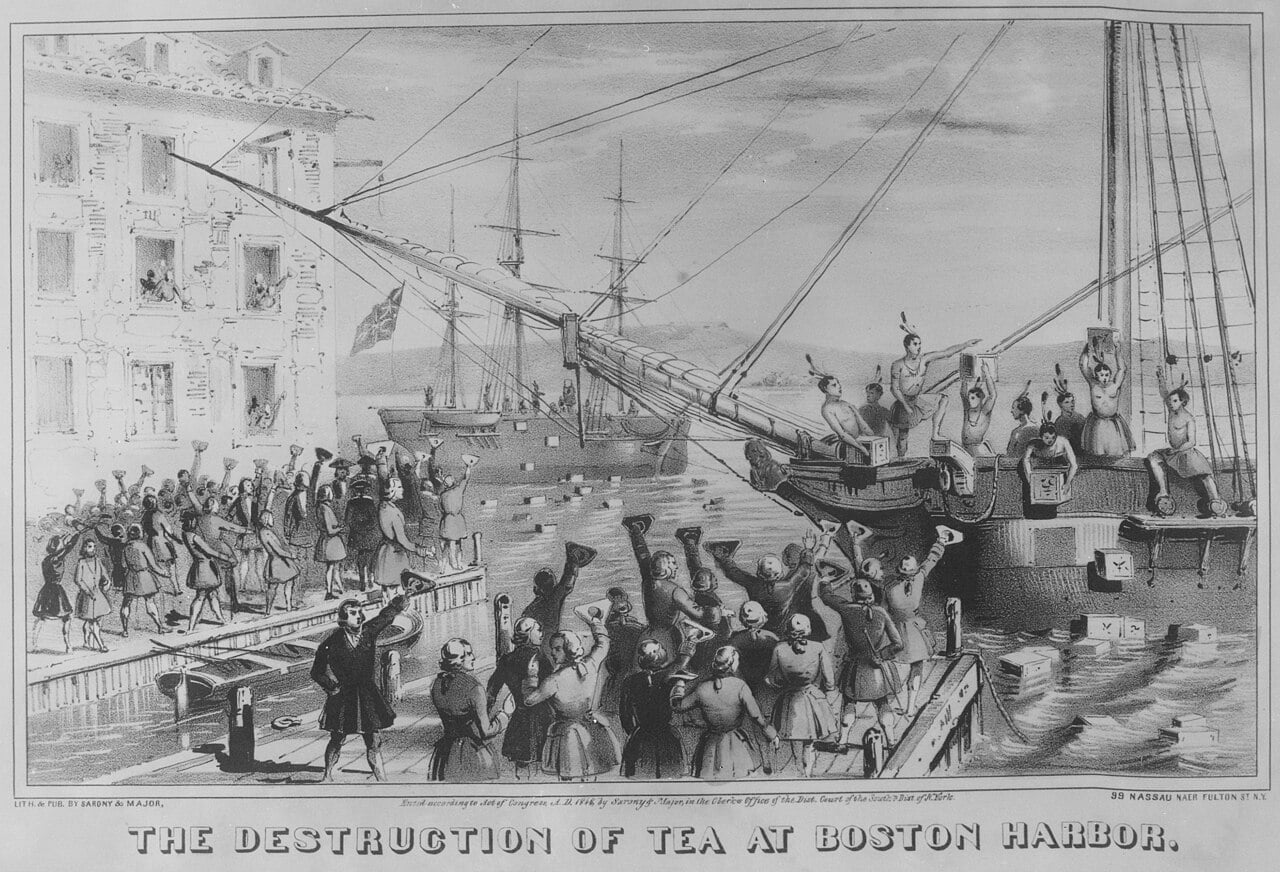
From that moment on, it became a patriotic American duty to avoid tea, and the coffeehouses profited as a result. As Benjamin Woods Labaree noted in The Boston Tea Party, an “anti-tea hysteria” ensued, engulfing all the colonies. The Continental Congress passed a resolution against tea consumption.
“Tea must be universally renounced,”
wrote John Adams to his wife in 1774, “and I must be weaned, and the sooner, the better.”
Of course, the North Americans also appreciated the fact that coffee was cultivated much nearer to them than tea and was consequently cheaper, while the Yankees profited from the slave trade that made coffee less expensive. Increasingly, over the course of the nineteenth century, they would rely on coffee grown in their own hemisphere. (Pendergrast Mark)
After the Boston Tea Party (1773) and the Revolutionary War (1812), Americans began importing high-quality coffee from Latin America. Whether they were drinking coffee or tea, coffeehouses served a similar purpose to that which they did in Great Britain, as places where business was done. In the 1780s, Merchant’s Coffee House, located on Wall Street in New York City, was home to the organization of the Bank of New York and the New York Chamber of Commerce.
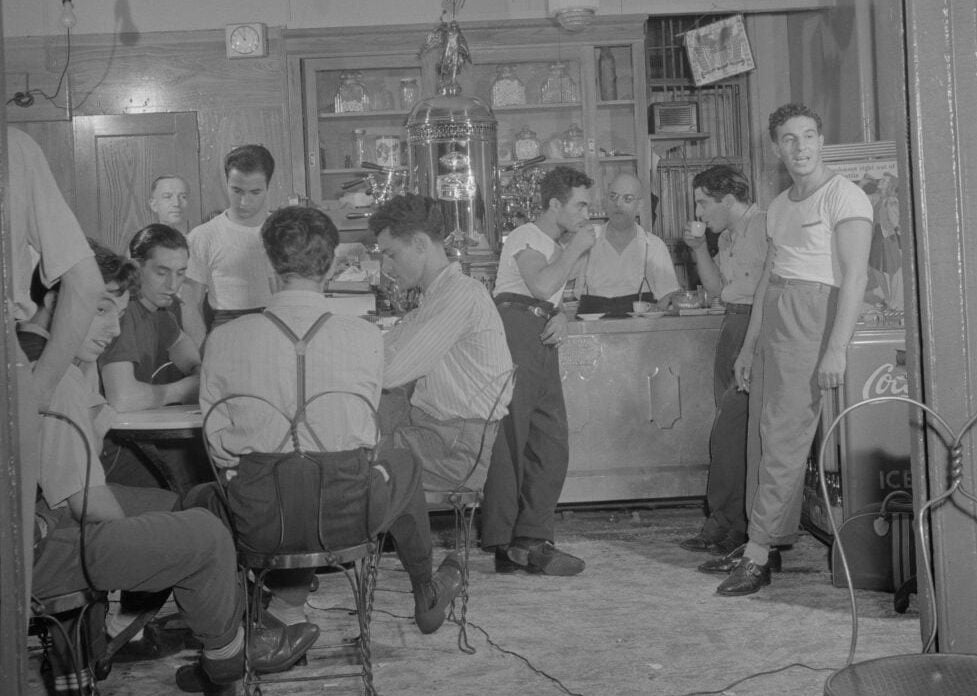
Later coffeehouses in the United States arose from the espresso and pastry-centered Italian coffeehouses of the Italian American immigrant communities in the major U.S. cities, notably New York City’s Little Italy and Greenwich Village, Boston’s North End, and San Francisco’s North Beach.
Coffee in Latin America
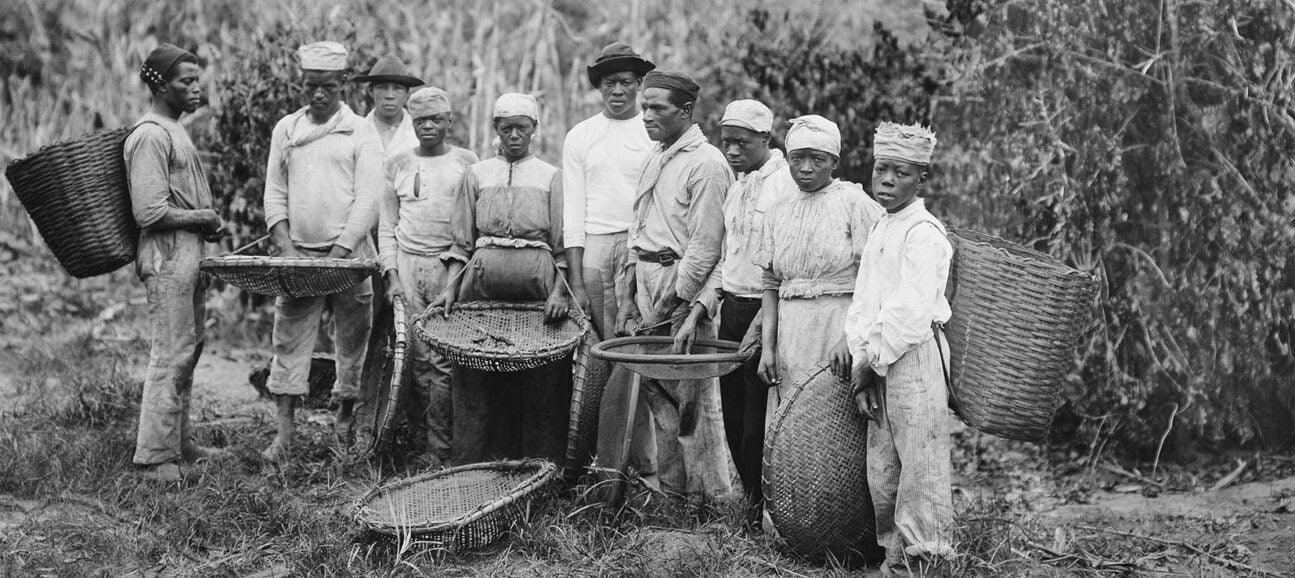
Coffee, cultivated on high-altitude slave plantations, became a popular drink in Europe and North America. Slaves had initially been brought from Africa to the Caribbean to harvest sugarcane.
Like coffee, sugar was popularized by the Arabs, and its popularity rose along with tea and coffee in the second half of the seventeenth century. The history of sugar is intimately tied to that of coffee. It was this sweetener that made the bitter boiled brew palatable to many consumers and added a quick energy lift to the stimulus of caffeine.
Macaco veio, macaco veio cafésaja come que?
Monkey came and the coffee bushes died. What do we eat now?
Brazilian slave song, circa 1800
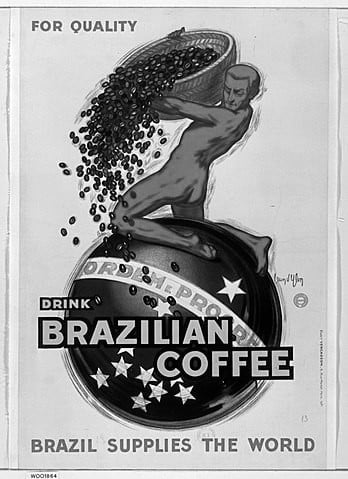
1931. Jean d’Ylen. CC0
By 1820, there were an estimated two million slaves in Portuguese-controlled Brazil, whose average life expectancy once arriving was seven years. Coffee production in Brazil exploded – coffee exports nearly tripled between 1890 and 1901. Interestingly, the coffee farmers thought of themselves as modern, progressive industrialists, not oppressors. There was only one exception of colonization that did not spell disaster for indigenous people and create a coffee oligarchy: Costa Rica, “where coffee paired with a more egalitarian ethos”, so Pendergrast.
He also says, that the coffee’s price would swing wildly due to speculation, politics, weather, and the hazards of war.
Coffee had become an international commodity that, during the latter part of the nineteenth century and would completely transform the economy, ecology, and politics of Latin America.
Coffee is our national misfortune.
Brazilian coffee grower, 1934
Coffee in India
Legend has it that a wandering Sufi mystic, Baba Budan, smuggled live coffee seeds from Mocha to India when he returned from the Hadj pilgrimage to Mecca. Near the caves where he and his followers had settled, Baba planted the fruits and grew the first Arabica plants in Mysore (today’s Karnataka) on the slopes of the Chandragiri.
Coffee historians believe, the Dutch brought coffee to India around 1680, growing coffee in the Malabar region. The British Journal of Mythic Society VII claims that in 1385, Emperor Harihara II of Vijayanagar (now Mysore) ordered that all imports for Peta Math enter tax-free in “return for coffee seeds,” putting the Dutch claim to primacy in doubt. As the East India Company slowly spread across hill stations and the rest of India, in the 1880s, coffee plantations went along with them.

Coffee in Java (Indonesia)
Little had changed by the early 1800s, when Dutch civil servant Eduard Douwes Dekker served in Java, Indonesia. He ultimately quit in protest to write the novel Max Havelaar, under the pen name Multatuli. Dekker wrote:
Strangers came from the West who made themselves lords of his [the native’s] land, forcing him to grow coffee for pathetic wages. Famine?
In rich, fertile, blessed Java—famine? Yes, reader. Only a few years ago, whole districts died of starvation. Mothers offered their children for sale to obtain food. Mothers ate their children.“
Not all coffee workers on estates have been oppressed. The fault lies not with the tree or the way coffee is grown, but with how those who labor to nurture and harvest it are treated. (Pendergrast Mark)
Europe is made up of coffee houses
George Steiner writes in Europe is made up of coffee houses, of Cafés:
The café is a place for assignation and conspiracy, for intellectual debate and gossip, for the flâneur and the poet or metaphysician at his notebook. It is open to all, yet it is also a club, a freemasonry of political or artistic-literary recognition and programmatic presence. A cup of coffee, a glass of wine, a tea with rum secures a locale in which to work, to dream, to play chess or simply keep warm the whole day. It is the club of the spirit and the poste-restante of the homeless.
In the Milan of Stendhal, in the Venice of Casanova, and in the Paris of Baudelaire, the café housed what there was of political opposition, of clandestine liberalism. Three principal cafés in imperial and inter-war Vienna provided the agora, the locus of eloquence and rivalry, for competing schools of aesthetics and political economy, of psychoanalysis and philosophy. Those wishing to meet Freud or Karl Kraus, Musil, or Carnap, knew precisely in which café to look at which Stammtisch to take their place.
Danton and Robespierre meet one last time at the Procope, Paris. When the lights go out in Europe in August 1914, Jaurès is assassinated in a café. In a Geneva café, Lenin writes his treatise on empiricism and plays chess with Trotsky.
In Italy, coffee culture is still part of daily life, like in the Fiorio in Turin, the Florian and the Quadri in Venice, the Savini in Milan, the Pedrocchi in Padua, the Michelangelo and the Giubbe Rosse in Florence, the Aragno and the Greco in Rome, the Caffè d’ Europa and the Gambrinus in Naples.
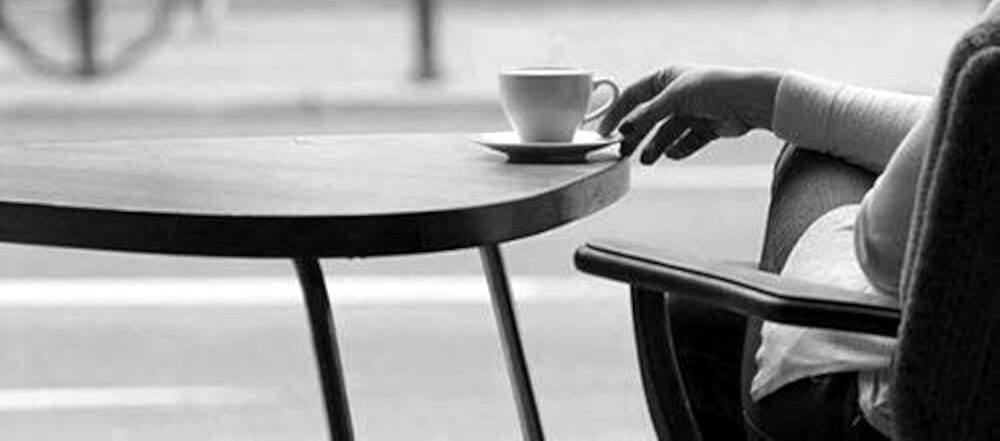
An English pub and an Irish bar have their own auras and mythologies. What would Irish literature be without the bars of Dublin? Where, if there had not been the Museum Tavern, would Dr. Watson have run into Sherlock Holmes? But these are not cafés. They have no chess-tables and no newspapers freely available to clients on their hangers. It is only very recently that coffee itself has become a public habit in Britain, and it retains its Italian halo.
The American bar plays a vital role in American literature, as evidenced by the iconic charisma of Scott Fitzgerald and Humphrey Bogart. The history of jazz is inseparable from it.
Cafes and coffeehouses in Europe created a special social space that contributed to the dissemination of culture. Different from the traditional tavern, the cafes offered a range of new beverages – imports into Europe, coffee, tea, and chocolate, which were noteworthy, above all, for being nonalcoholic – and a new social environment. From the first Ottoman coffeehouses to your local bar or coffee shop, they are part of our daily lives, in all their glorious diversity.
~ ○ ~
Keep exploring:
Works Cited & Multimedia Sources
The history of coffee is an extraordinary study. If you would like to learn more about it, I heartily recommend the book, All About Coffee, by William Ukers. Written in 1928, it will delight you with detail.
- https://www.histouring.com/en/historical-places/demel/
- Lemaire Gérard-Georges. I Caffè letterari. 1988.
- Ben Johnson https://www.historic-uk.com/CultureUK/English-Coffeehouses-Penny-Universities/
- George Steiner. Europe is made up of coffee houses, of Cafés.Historic Cafes Route
- https://en.wikipedia.org/wiki/Caff%C3%A8_sospeso
- Allegra World Coffee Portal www.worldcoffeeportal.com
- Artusi Pellegrino. Science in the Kitchen and the Art of Eating Well, transl. Murtha Baca and Stephen Sartarelli. 2003.
- Biderman Bob. A people’s history of coffee and cafés. 2013.
- Café Culture Magazine www.cafeculturemagazine.co.uk
- Carosello Bialetti: la caffettiera diventa mito https://www.famigliacristiana.it/video/carosello-bialetti-moka-mito.aspx
- Cociancich Maurizio. Storia dell’ espresso nell’Italia e nel mondo. 100% Espresso Italiano. 2008.
- Coffee Connaisseur www.coffeeconnaisseur.com
- Coffee Geek www.coffeegeek.com
- Coffee Origins’ Encyclopedia www.supremo.be
- Coffee Research www.coffeeresearch.org
- Coffee Review www.coffeereview.com
- Coffee Sage www.coffeesage.com
- Coffeed.comwww.coffeed.com
- Comunicaffe International www.comunicaffe.com
- Davids Kenneth. Espresso Ultimate Coffee. 2001.
- De Crescenzo Luciano. Caffè sospeso. Saggezza quotidiana in piccoli sorsi. 2010.
- De Crescenzo. Luciano. Il caffè sospeso.
- Eco Umberto. “La Cuccuma maledetta” in Agostino Narizzano, Caffè: Altre cose semplici. 1989.
- Global Coffee Report www.gcrmag.com
- Gusman Alessandro. Antropologia dell’olfatto. 2004.
- Hippolyte Taine, wrote in, Italy: Florence and Venice, trans J. Durand. 1869.
- https://www.italienaren.org/tradizioni-italiane-caffe-in-ginocchio/
- http://www.archiviograficaitaliana.com/project/322/illycaff
- http://www.baristo.university/userfiles/PDF/INEI-M60-ENG-Public-Regulation-EICH-v4-1.pdf
- http://www.coffeetasters.org/newsletter/en/index.php/category/a-baristas-life/
- http://www.coffeetasters.org/newsletter/it/index.php/il-galateo-del-caffe/01524/
- http://www.culturaacolori.it/fascismo-contro-le-parole-straniere/
- http://www.espressoitaliano.org/en/The-Certified-Italian-Espresso.html
- http://www.inei.coffee/en/Welcome.html
- https://archiviostorico.fondazionefiera.it/entita/585-bialetti-industrie
- https://bialettistory.com/
- https://cdn.intechopen.com/pdfs/55623.pdf Severini Carla. Derossi Antonio. Ricci Ilde. Fiore Anna Giuseppina. Caporizzi Rossella. How Much Caffeine in Coffee Cup? Effects of Processing Operations, Extraction Methods and Variables
- https://en.wikipedia.org/wiki/Drip_coffee#Cafeti%C3%A8re_du_Belloy
- https://en.wikipedia.org/wiki/ISSpresso
- https://en.wikipedia.org/wiki/Italian_meal_structure
- https://en.wikipedia.org/wiki/Neapolitan_flip_coffee_pot
- https://hal.science/hal-00618977/document
- https://hub.jhu.edu/magazine/2023/spring/jonathan-morris-coffee-expert/
- https://ineedcoffee.com/the-story-of-the-bialetti-moka-express/
- https://it.wikipedia.org/wiki/Caff%C3%A8
- https://it.wikipedia.org/wiki/Caff%C3%A8#Risvolti_etici_e_sociali
- https://it.wikipedia.org/wiki/Napoletana
- https://italofonia.info/la-politica-linguistica-del-fascismo-e-la-guerra-ai-barbarismi/
- https://italysegreta.com/italian-hospitality-the-invite/
- https://library.ucdavis.edu/wp-content/uploads/2022/06/LangPrize-2017-ElizabethChan-Project.pdf
- https://memoriediangelina.com/2009/08/11/italian-food-culture-a-primer/
- https://mostre.cab.unipd.it/marsili/en/130/the-everyday-eighteenth-century
- https://napoliparlando.altervista.org/cuccumella-la-caffettiera-napoletana/
- https://specialcoffeeitaly.com/barista-espresso-coffee-machine/
- https://specialcoffeeitaly.com/italian-breakfast-cappuccino-cornetto/?_gl=1*1gjfoya*_ga*OTE0MDM2ODM5LjE2OTMzNjE5OTg.*_ga_2HTE5ZB0JS*MTY5MzM2MTk5Ny4xLjEuMTY5MzM2Mjk0NS4wLjAuMA../
- https://specialcoffeeitaly.com/what-came-first-the-italian-bar-or-coffee/
- https://themokasound.com/
- https://uwyoextension.org/uwnutrition/newsletters/understanding-different-coffee-roasts/
- https://www.adir.unifi.it/rivista/1999/lenzi/cap2.htm
- https://www.bialetti.co.nz/blogs/making-great-coffee/using-bialetti-coffee-makers
- https://www.bialetti.com/ee_au/our-history?___store=ee_au&___from_store=ee_en
- https://www.bialetti.com/it_en/inspiration/post/ground-coffee-for-moka-should-never-be-pressed
- https://www.brepolsonline.net/doi/pdf/10.1484/J.FOOD.1.102222
- https://www.coffeeartproject.com/TheCollection/Amsterdam/2014.aspx
- https://www.coffeeartproject.com/TheCollection/Amsterdam/2014.aspx
- https://www.coffeeartproject.com/TheCollection/Milan/2013/Gallery/Other/Amalia-Chieco
- https://www.coffeeartproject.com/TheCollection/NewYork/2016.aspx
- https://www.coffeeartproject.com/TheCollection/NewYork/2017.aspx
- https://www.coffeeartproject.com/TheCollection/NewYork/2018.aspx
- https://www.coffeeartproject.com/TheCollection/NewYork/2019.aspx
- https://www.coffeeresearch.org/science/aromamain.htm
- https://www.coffeereview.com/coffee-reference/from-crop-to-cup/serving/milk-and-sugar/
- https://www.comitcaf.it/
- https://www.ecf-coffee.org/wp-content/uploads/2023/05/European-Coffee-Report-2022-2023.pdf
- https://www.espressoitalianotradizionale.it/
- https://www.euronews.com/culture/2022/02/15/the-italian-espresso-makes-a-bid-for-unesco-immortality
- https://www.faema.com/int-en/product/E61/A1352IILI999A/e61-legend
- https://www.finestresullarte.info/en/works-and-artists/the-bialetti-moka-the-ultimate-romantic-design-object
- https://www.finestresullarte.info/opere-e-artisti/moka-bialetti-oggetto-design-ultimi-romantici
- https://www.freemalaysiatoday.com/category/leisure/food/2022/02/15/italy-woos-unesco-with-magic-coffee-ritual/
- https://www.gaggia.com/legacy/
- https://www.gamberorossointernational.com/news/coffee-10-false-myths-to-dispel-on-the-beverage-most-loved-by-italians/
- https://www.gcrmag.com/calls-to-review-price-structure-of-italian-espresso/
- https://www.granaidellamemoria.it/index.php/it/archivi/caffe-espresso-italiano-tradizionale
- https://www.illy.com/en-us/coffee/coffee-preparation/how-to-make-moka-coffee
- https://www.illy.com/en-us/coffee/coffee-preparation/how-to-use-neapolitan-coffee-maker
- https://www.ilpost.it/2011/06/08/itabolario-bar-1897/
- https://www.itstuscany.com/en/bar-where-the-word-comes-from/“Cafe Hawelka”, John A. Irvin
- https://www.lastampa.it/verbano-cusio-ossola/2016/02/17/news/le-ceneri-di-renato-bialetti-nella-sua-moka-con-i-baffi-1.36565348/
- https://www.lavazza.com/en/coffee-secrets/neapolitan-coffee-maker
- https://www.lavazzausa.com/en/recipes-and-coffee-hacks/making-espresso-at-home
- https://www.linkedin.com/pulse/third-wave-coffee-meets-tradition-neapolitan-maker-bruno-lopez
- https://www.mumac.it/we-love-coffee-en/be-our-guest-en/progettazione-e-rito/?lang=en
- https://www.quartacaffe.com/images/pdf/carta-dei-valori.pdf
- https://www.repubblica.it/il-gusto/2021/07/26/news/caffe_il_piu_clamoroso_equivoco_gastronomico_d_italia-311835974/
- https://www.taccuinigastrosofici.it/ita/news/contemporanea/semiotica-alimentare/print/Pop-cibo-di-sostanza-e-circostanza.html
- https://www.thehistoryoflondon.co.uk/coffee-houses/
- https://www.wien.gv.at/english/culture-history/viennese-coffee-culture.html
- Illy Andrea. Viani Rinantonio. Furio Suggi Liverani. Espresso Coffee. The Science of Quality. 2005.
- International Coffee Organization www.ico.org
- Kerr Gordon. A Short History of Coffee. 2021.
- La cremina per il caffè: come farla bene. https://www.lacucinaitaliana.it/news/cucina/come-fare-la-cremina-del-caffe/
- Allen Lee Stewart. Devil’s Cup. A History of the World According to Coffee. 1999.
- Leonetto Cappiello – Wikipedia page on the creator of the 1922 poster La Victoria Aduino.
- Markman Ellis. The Coffee House. A Cultural History. 2005.
- Mennell Stephen. All Manners of Food. Eating and Taste in England and France. 1996.
- Montanari Massimo. Il riposo della polpetta e altre storie intorno al cibo. 2011.
- Montanari Massimo. Il sugo della storia. 2018.
- Morris Jonathan. A Short History of Espresso in Italy and the World. Storia dell’espresso nell’Italia e nel mondo. In M. Cociancich. 100% Espresso Italiano. 2008.
- Morris Jonathan. Coffee: A Global History. 2019.
- Morris Jonathan. Making Italian Espresso, Making Espresso Italian.
- National Coffee Association www.ncausa.org
- Pazzaglia Riccardo. Odore di Caffe’. 1999.
- Pendergrast Mark. Uncommon Grounds. The History of Coffee and How It Transformed Our World. 2019.
- Perfect Daily Grind www.perfectdailygrind.com
- Scaffidi Abbate Mario. I gloriosi Caffè storici d’Italia. Fra storia, politica, arte, letteratura, costume, patriottismo e libertà. 2014.
- Schnapp Jeffrey. The Romance of Caffeine and Aluminum. Critical Inquiry. 2001.
- Sibal Vatika. Food: Identity of culture and religion. 2018.
- Specialty Coffee Association www.sca.coffee
- Spieler Marlena. A Taste of Naples. 2018.
- Tea and Coffee Trade Journal www.teaandcoffee.net
- The Long History of the Espresso Machine. www.smithsonianmag.com
- The Pleasures and Pains of Coffee by Honore de Balzac
- The relaxation ritual https://themokasound.com/
- Tucker, Catherine M. Coffee Culture: Local Experiences, Global Commensality, Society and Cuture 2011.
- Virtual Coffee www.virtualcoffee.com
- World Coffee Research www.worldcoffeeresearch.org
